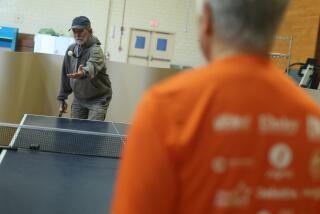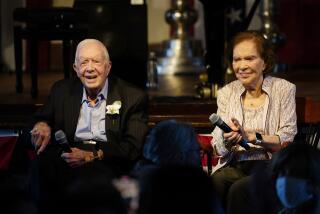Dramatic Drop Seen in Deaths, Nursing Care : New Program Key to Independence for Elderly?
- Share via
BOSTON — Hospitals could keep 200,000 Americans out of nursing homes each year by establishing wards that concentrate on making elderly patients well enough to live on their own, a study concludes.
About 10 million people over age 65 are hospitalized annually, and 8% of them are sent to nursing homes when their hospital stays are over. Now, a Veterans Administration report estimates that a quarter of those--or 200,000--could avoid nursing homes if their disabilities were properly assessed and treated.
The treatment is based in geriatric evaluation units, specialized wards that have begun to appear in large medical centers. One of the first in the country was at the VA Medical Center in Sepulveda, Calif., where doctors conducted a one-year follow-up to see how well the special care was working.
The study showed that the treatment dramatically reduced nursing home admissions and deaths among elderly patients.
“The goal is to find and treat the reversible ailments of aging--which tend to be very numerous and complex in the over-70 population--and to arrange for optimal post-discharge care,” said Dr. Lawrence Z. Rubenstein, who directed the study.
Among those staffing the units are physicians, social workers, psychologists, dietitians, therapists and nurses. They work to improve the elderly patients’ health, fine-tune their drug therapy and help their families.
The latest report, published in the New England Journal of Medicine, was based on the experiences of 123 frail, elderly patients. Half were admitted to the evaluation unit, while the rest got ordinary care.
Only 13% of the patients from the special unit had to be sent to nursing homes. The rest went home or to housing complexes for the elderly. But 30% of those in the second group entered nursing homes.
In the year since their discharge, 24% of the unit’s patients died, contrasted with 48% of the others.
“We hadn’t really expected a very large effect on survival,” Rubenstein said in an interview. “We were very amazed that we reduced the one-year mortality by 50% by having people go through our program.”
People treated in the units spent three or four weeks longer than usual in the hospital, so initially their medical bills were higher. But in the year that followed, they had substantially smaller medical expenses.
“The initial investment was more than made up for,” Rubenstein said. “There appear to be substantial savings from these units.”
A recent Veterans Administration report recommended that all VA hospitals open the evaluation units over the next 15 years. The Sepulveda ward, which opened in 1979, was modeled on programs in Great Britain, where the approach has been used routinely for several decades.
More to Read
Sign up for Essential California
The most important California stories and recommendations in your inbox every morning.
You may occasionally receive promotional content from the Los Angeles Times.













